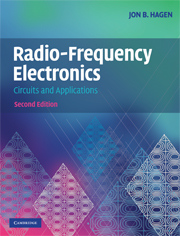Book contents
- Frontmatter
- Contents
- Preface
- 1 Introduction
- 2 Impedance matching
- 3 Linear power amplifiers
- 4 Basic filters
- 5 Frequency converters
- 6 Amplitude and frequency modulation
- 7 Radio receivers
- 8 Suppressed-carrier AM and quadrature AM (QAM)
- 9 Class-C, D, and E Power RF amplifiers
- 10 Transmission lines
- 11 Oscillators
- 12 Phase lock loops and synthesizers
- 13 Coupled-resonator bandpass filters
- 14 Transformers and baluns
- 15 Hybrid couplers
- 16 Waveguide circuits
- 17 Small-signal RF amplifiers
- 18 Demodulators and detectors
- 19 Television systems
- 20 Antennas and radio wave propagation
- 21 Radar
- 22 Digital modulation techniques
- 23 Modulation, noise, and information
- 24 Amplifier and oscillator noise analysis
- 25 The GPS Navigation system
- 26 Radio and radar astronomy
- 27 Radio spectrometry
- 28 S-parameter circuit analysis
- 29 Power supplies
- 30 RF test equipment
- Index
- References
22 - Digital modulation techniques
Published online by Cambridge University Press: 05 June 2012
- Frontmatter
- Contents
- Preface
- 1 Introduction
- 2 Impedance matching
- 3 Linear power amplifiers
- 4 Basic filters
- 5 Frequency converters
- 6 Amplitude and frequency modulation
- 7 Radio receivers
- 8 Suppressed-carrier AM and quadrature AM (QAM)
- 9 Class-C, D, and E Power RF amplifiers
- 10 Transmission lines
- 11 Oscillators
- 12 Phase lock loops and synthesizers
- 13 Coupled-resonator bandpass filters
- 14 Transformers and baluns
- 15 Hybrid couplers
- 16 Waveguide circuits
- 17 Small-signal RF amplifiers
- 18 Demodulators and detectors
- 19 Television systems
- 20 Antennas and radio wave propagation
- 21 Radar
- 22 Digital modulation techniques
- 23 Modulation, noise, and information
- 24 Amplifier and oscillator noise analysis
- 25 The GPS Navigation system
- 26 Radio and radar astronomy
- 27 Radio spectrometry
- 28 S-parameter circuit analysis
- 29 Power supplies
- 30 RF test equipment
- Index
- References
Summary
Digital modulation is both the newest and the oldest radio technique. Morse code transmissions were strictly binary, with “key down” and “key up” equivalent to multiplying the carrier by one or zero. Many modern systems also use binary keying, but the zero state is usually signaled by reversing the polarity of the signal (binary phase-shift keying, BPSK) or by shifting the frequency (binary frequency-shift keying, BFSK). This improves the probability of distinguishing zeros from ones in the presence of noise.
In this chapter we look first at some of the methods used for binary and “m-ary” modulation. We then see how specially shaped pulses can be used with these methods in order to avoid intersymbol interference when the pulses, dispersed in time, partially overlap at the receiver. The “8-VSB” system used for digital television in the U.S. (see Chapter 19) provides an example of pulse amplitude modulation (PAM). Finally, we discuss two newer digital modulation systems: multicarrier and spread spectrum. A glossary is provided at the end of this chapter, listing the many common abbreviations used (BPSK, BFSK, 8-VSB, PAM, etc.).
Digital modulators
Digital modulation differs from analog modulation in that only a discrete set of states (in the space of amplitudes, phases, and frequencies) is used, and that the time devoted to any state is always an integral multiple of a basic time-step. The state during this time period constitutes a transmitted “symbol,” and the symbol rate is one of the parameters defining a modulation system.
- Type
- Chapter
- Information
- Radio-Frequency ElectronicsCircuits and Applications, pp. 300 - 320Publisher: Cambridge University PressPrint publication year: 2009



